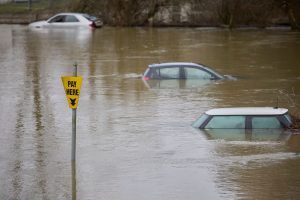 Spending for Stability: Where the 2025 Spending Review Aligns with National Risks and Resilience
Spending for Stability: Where the 2025 Spending Review Aligns with National Risks and Resilience
Government spending decisions shape the systems we rely on every day, from energy and transport to communications and environmental protection. As individuals and communities we feel the impact of these investments (or non-investment). As resilience professionals, we also look for the signals that show how risk is being managed, capabilities developed, and future challenges anticipated.
The Spending Review 2025 makes several explicit references to resilience. These are a welcome signpost that government strategy is not only focussed on response, but increasingly on building systems that can anticipate and prevent disruption and recover quickly when things go wrong.
The review sets out investment plans for infrastructure, supply chains, energy, and climate adaption, amongst several other issues for society. Most of the announcements in the review are framed through the lens of enhancing security, innovation or economic growth. But for those working in preparedness, risk management, and continuity planning, these priorities speak to something more; a growing recognition that resilience must be embedded in everyday systems, not bolted on during a crisis.
This article highlights some of the key signposts within the Spending Review 2025 that point to a more resilience-focussed approach – from secure supply chains to cyber capability, energy strategy to national preparedness. Each topic offering a glimpse into how resilience is being embedded into the systems we rely upon every day.
Supply Chains
Supply chains rarely make headlines, that is, until they break. From fuel shortages at pumps to toilet roll not on shelves, recent years have shown just how exposed society can be when the systems that move goods around the world and our country can’t meet the demand and fail. The 2025 Spending Review recognises growing challenges in the movement of goods and services.
“Supply chains are increasingly volatile, security threats are rising, and international partnerships are changing”
(Spending Review 2025: 2.21)
In response, it outlines investment in infrastructure, energy, and manufacturing sectors, framed in part as a way to strengthen the UKs resilience.
“This includes capital investment in transport infrastructure, clean energy and industrial decarbonisation to support supply chain resilience”
(Spending Review 2025: 2.22b)
For resilience professionals, these statements highlight a shift in emphasis, placing supply chain stability alongside innovation, decarbonisation, and growth. The references suggest that ensuring continuity of essential goods and services is being considered at a strategic level.
Climate Resilience
The 2025 Spending Review makes a direct link between environmental policy and national resilience. It outlines a multi-year commitment to climate adaptation, with a specific focus on flood risk and the ecosystems that support food security and the wider economy.
“The Government is also investing in climate adaptation and the natural environment to increase the UK’s resilience to the effects of climate change and to protect the ecosystems that underpin the economy and food security.”
(Spending Review 2025: 4.61)
Flooding continues to be a central focus of this work. The review confirms sustained funding to build and maintain flood defences.
“This settlement also prioritises progress on the government’s growth mission by committing… to build and maintain flood defences, protecting communities across England from the dangers of flooding.”
(Spending Review 2025: 4.62)
These commitments reflect a broader recognition that resilience to climate-related risks must be built into how infrastructure, land use, and environmental resources are managed. The emphasis on both physical defences and ecosystem protection suggests a move towards long-term, preventative strategies that reduce vulnerability and support continuity across communities and sectors.
Cyber Security
As more essential services rely on digital systems, the resilience of the UK’s cyber infrastructure has become a critical part of national preparedness. The Spending Review reflects this shift, highlighting continued investment in national security capabilities, including those responsible for monitoring and responding to emerging threats.
“The settlement also provides funding to support the National Cyber Security Centre and the National Protective Security Authority in continuing their important role in the government’s growth mission.”
(Spending Review 2025: 2.11)
These organisations work closely with the intelligence services to assess risk and identify threats, supporting both national policy and local operational readiness. Cyber security is also included in a broader programme of cross-departmental collaboration:
“The Integrated Security Fund will support capabilities in areas including cybersecurity, biosecurity and resilience where delivery relies on partnership across a number of government departments, as well as the private sector.”
(Spending Review 2025: 2.13)
These refences highlight that threats, as a result of deliberate hostile action, are emphasised within spending policy. Cyber risk requires active monitoring, technical expertise and joined-up planning. The emphasis on collaboration is of particular interest to the UK Resilience Academy as it is part of the objectives we have set ourselves to be a collaborative and convening body. It is encouraging to see this highlighted in government policy.
Energy Resilience
Reliable access to energy underpins every aspect of daily life. From public services and supply chains to communications and healthcare, our dependence on energy is an ever-increasing demand. A loss of electrical systems can result in critical utilities being impacted, and society suffering widespread disruption. The 2025 Spending Review includes a range of commitments aimed at strengthening the UK’s energy system, with an emphasis on infrastructure development, domestic generation and long-term affordability.
While framed within the review as economic growth and decarbonisation, these investments also support national resilience by reducing exposure to global market volatility and system stress. Support for new nuclear projects, renewable energy, and grid upgrades contributes to a more robust and diversified energy mix.
investments also support national resilience by reducing exposure to global market volatility and system stress. Support for new nuclear projects, renewable energy, and grid upgrades contributes to a more robust and diversified energy mix.
For those working in risk, planning, and continuity, this reinforces the importance of factoring energy assumptions and interdependencies into local resilience strategies.
From Risk Register to Spending Strategy: Connecting Investment with National Priorities
All of the topics outlined above are reflected across multiple entries within the UK National Risk Register, updated in 2025. Addressing these through government spending is a signal that these risks are not just acknowledged, but actively being planned for at the national level.
The National Risk Register outlines the most serious risks the UK is exposed to, including natural hazards (such as extreme weather or flooding) and threats (such as cyber-attacks and deliberate supply chain disruption). Many of the priorities in the spending review align closely with these scenarios.
By linking spending decisions to risk-based planning, the UK Government appears to be signalling a shift in emphasis from reacting to emergencies after they occur, to embedding resilience into the systems that underpin daily life. For resilience professionals, this alignment reinforces the importance of using the National Risk Register as a shared frame of reference across regions, agencies, sectors and disciplines.
Conclusion
The Spending Review 2025 reflects a broader shift in how resilience is being approached across Government, not as a separate emergency function, but as something built into the design of everyday systems. From secure supply chains to flood defences, energy networks to cybersecurity, the review signals an intent to invest in the conditions that prevent disruption, not just respond to it.
For citizens this means greater continuity in essential services and infrastructure. For resilience professionals, it underlines the value of working across boundaries; linking policy, planning, and practice to the real risks outlined in the National Risk Register.
While the detail is still to emerge, with the Government’s Resilience Plan due to be published imminently, the direction of travel is clear:
Resilience is no longer an optional add-on, but a core part of how the UK prepares and builds for the future.
We can help
The UK Resilience Academy is committed to supporting the nation to be better prepared for current and future risks. Review the advisory and exercising services available to help your business become more resilient here, courses for individuals to help build your skills or you can tailor our courses to suit your team or organisation with a bespoke offering, we’d be happy to discuss all options.

Article written by Joshua Isherwood, Resilience Capability Lead for Preparedness.





